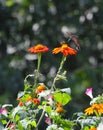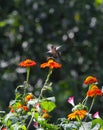The ruby-throated hummingbird (Archilochus colubris) is a species of hummingbird that generally spends the winter in Central America, Mexico, and Florida, and migrates to Canada and other parts of Eastern North America for the summer to breed. It is the most common hummingbird in eastern North America, having population estimates of about 35 million in 2021. Most bumblebees are social insects that form colonies with a single queen. Bumblebees have round bodies covered in soft hair (long branched setae) called 'pile', making them appear and feel fuzzy. Like their relatives the honeybees, bumblebees feed on nectar, using their long hairy tongues to lap up the liquid the proboscis is folded under the head during flight.
|






